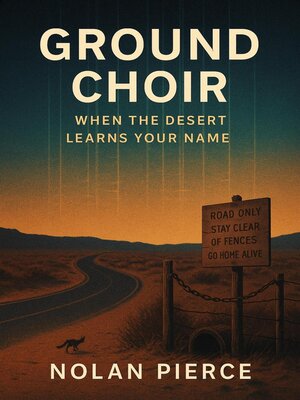
Sign up to save your library
With an OverDrive account, you can save your favorite libraries for at-a-glance information about availability. Find out more about OverDrive accounts.
Find this title in Libby, the library reading app by OverDrive.



Search for a digital library with this title
Title found at these libraries:
| Library Name | Distance |
|---|---|
| Loading... |
On a sunburned mile of county road, a field seismologist points a "waterfall window" at the ground and watches a pattern appear: human footsteps clustering along a shallow curve near an abandoned fence. It looks like a calling. It isn't. In Ground Choir—a desert gothic techno-thriller with the hush of slow-burn suspense—the "voice" turns out to be coupling: geometry, buried fiber, and human behavior slipping into rhythm.
Evan Hale wants proof; Rae Montano wants people alive; Deputy Lena Timmons wants quiet weekends that stay quiet. When a viral livestream pulls crowds toward the curve, small-town calm becomes a small-town mystery with very real stakes. The county doesn't need exorcism—it needs stewardship. Daylight-only work, off-beat rollers, calibrated shakers, and taped-over switches set to SYNC: OFF become their tools to "detune" the mile and unteach the land a dangerous habit.
As the team fights platform attention, utility optics, and academic neatness, the book shifts from spook to procedure—more procedural thriller than campfire tale, more policy than potion. A near-fatal surge forces hard choices, an open hearing turns rumor into rule (no night operations, soft perimeters, a public "boring dashboard"), and Evan must let grief stay where it belongs: in memory, not in the soil. This is folk horror stripped of the supernatural and rebuilt with permits, signage, and neighbors who learn how to be bored on purpose.
Set in the American Southwest, Ground Choir blends technical clarity with an eerie, humane gaze. You'll learn to read the spectrogram like a new sky—trucks as wide bands, wind as gauze, a fox as a low, delicate trace that hesitates at a culvert, then slips on. By the final pages, the mile is quiet again—not because a monster was slain, but because ordinary people chose the unglamorous work that keeps communities safe. Part psychological thriller, part systems parable, this is an atmospheric story about how places learn from us—and how we choose what to keep.
If you like razor-precise ambiance, civic stakes, and the uncanny hiding in infrastructure, this desert gothic will stay under your skin long after the screen goes blue.







